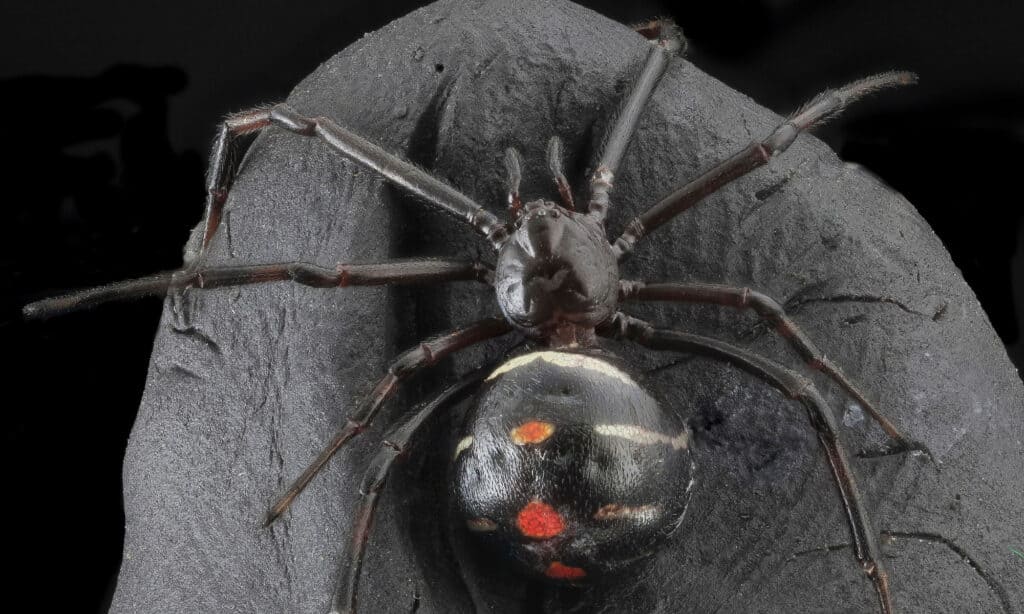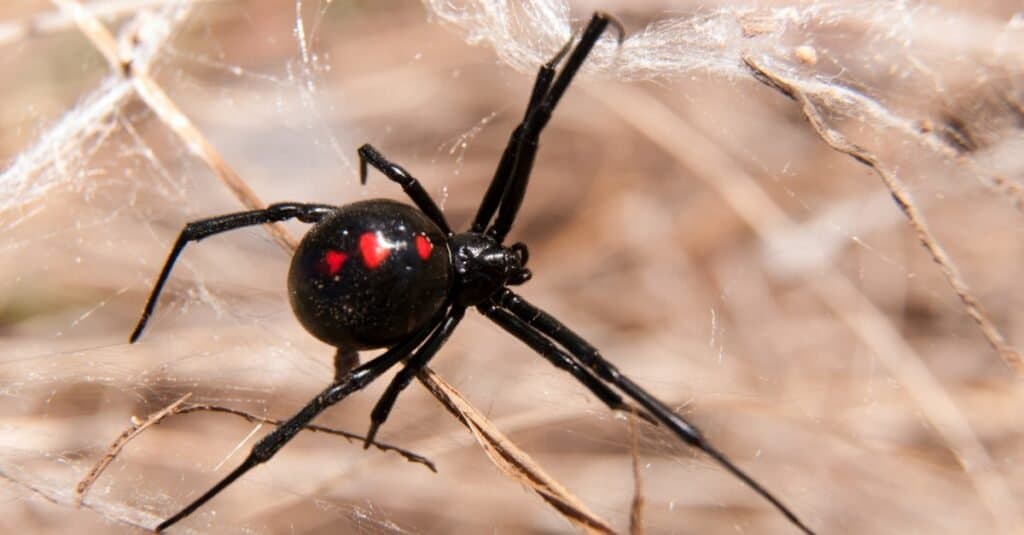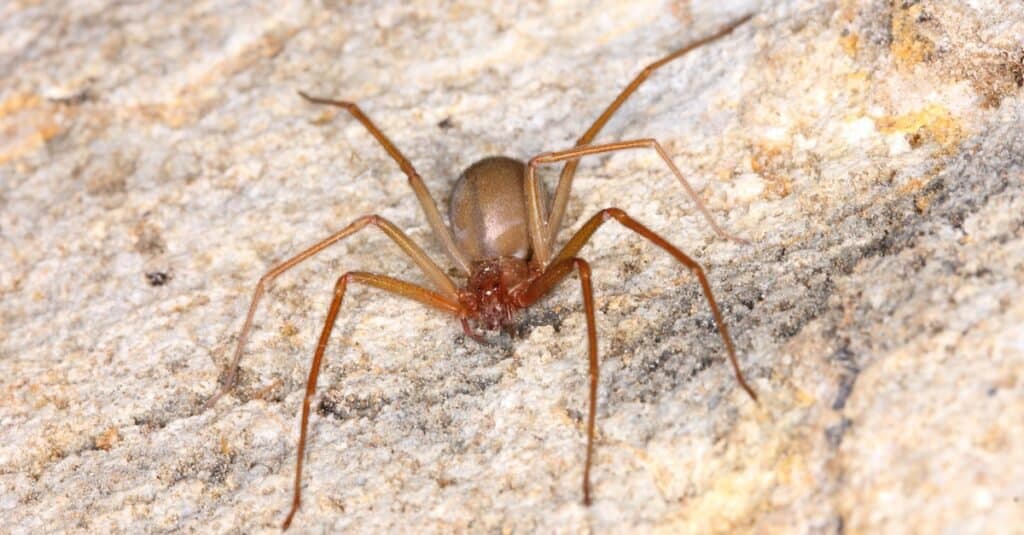Spiders are found worldwide on every continent except for Antarctica. In Maryland, summer is their most active period, and the reason for this is not far-fetched –the humid, warm temperature is ideal for them to find food, shelter, and breed. So they often come out in droves and it’s hard to escape them roaming around your yard at this time of the year. Although spiders are widely feared, most are actually not dangerous to humans.
Of all species of spiders in Maryland, only two have venom powerful enough to cause potentially life-threatening symptoms in humans; the infamous black widow spider and the brown recluse spider. The brown recluse is not naturally occurring in Maryland but has been reportedly seen in some areas in the state. So you’ll want to keep an eye out for them.
This article focuses on Maryland’s most dangerous spiders and how you can identify them to stay out of harm’s way.
1. Black Widow Spider

Unlike other black widows, northern black widows have a broken hourglass-shaped marking on their abdomens
©Porco_Rosso/Shutterstock.com
Black widow spiders are the most common and the only venomous species native to Maryland that poses a potential danger to humans. They are an easily recognizable species seen in Maryland during the summer.
How to Identify a Black Widow Spider
No other spider in Maryland looks like the black widow. Female black widow spiders are readily identifiable by the bright red or orange hourglass-shaped markings on the underside of their abdomen, and some may have a row of red spots above or no marking at all. Males of this species are half the size of females, but females usually have longer legs and are about ¼ inches to ⅜ inches (0.6 cm to 0.95cm) long. Male black widow spiders have red markings on the dorsal surface of the abdomen, and juveniles have a similar pattern to the males. Black widow spiders have bristles on their hind legs, which allows them to cover their prey with strong silk.
Where are Black Widow Spiders Found in Maryland?
Black widow spiders are found in dry areas, dimly lit locations, and cluttered areas in Maryland. Because they are an outdoor species, the best places to look for them include overhanging ledges, beneath benches or stones, around outbuildings, or near entrances to abandoned rodent burrows. They can also be found in tool sheds, garages, water meters, rock piles, old lumber piles, and trash piles. However, they may find their way indoors by hiding in items such as flower pots, boxes, baskets, or other objects stored outdoors for some time.
How Dangerous are Black Widow Spiders?

Female black widow spiders kill and eat males after mating.
©Sari ONeal/Shutterstock.com
Black widow spiders got their name from the gruesome ritual of the females killing and eating the males after mating. No other spider in Maryland is as dangerous as the black widow spider. Aside from their bite being extremely painful, the venom from a single bite is highly toxic –about 15 times stronger than a rattlesnake‘s venom –and can even be fatal if left untreated. A black widow’s bite contains a neurotoxic venom capable of affecting the nervous system and may result in systemic effects, such as severe muscle pain, sweating, muscle cramps, abdominal cramps, and tachycardia. Symptoms usually last for days and may even persist for several weeks.
Contrary to popular belief, black widows are not aggressive spiders and rarely bite humans unless threatened or startled. They may also bite defensively when pressed against surfaces or if their web is disturbed. So be careful when working in areas where they may be found. Though black widow spider bite is rare, be aware that if you or anyone you know gets bitten, it’s important to seek medical attention immediately. Children and the elderly are especially susceptible to complications due to compromised immune systems.
2. Brown Recluse Spider

©Nick626/Shutterstock.com
In actuality, the brown recluse spider is not native to Maryland, so it is not commonly found here. Brown recluses are transported into the state through packages or by people who move from the Midwest and the Southwest, where they normally occur. Here’s how to spot brown recluse spiders in Maryland this summer:
How to Identify a Brown Recluse Spider?
Brown recluse spiders are medium-sized, usually between 0.24 and 0.79 inches (6 mm to 20 mm) long, but some individuals may grow larger. These eight-legged arachnids are typically light to medium brown, but they may range in color from white to dark brown or blackish gray. The cephalothorax (combined head and thorax) is not necessarily the same color as the abdomen.
Brown recluse spiders have distinct markings on the dorsal surface of their cephalothorax with a long black line, forming a violin-shaped pattern with the neck of the violin pointing toward the rear of the spider. The color pattern does not extend to the abdomen and leg because they have a uniformly colored abdomen with no stripes or bands. The intensity of the violin pattern can vary depending on the spider’s age, with mature brown recluse spiders typically having darker violin shapes.
Where are Brown Recluse Spiders Found in Maryland?
Brown recluses are more common in the central Midwest and the south-central United States. As we said earlier, brown recluse spiders have no known population in Maryland. Experts believe they are brought into Maryland in packages, moving or shipping boxes from the south, and then stay up during the warm summer months. The brown recluse spider prefers to live in hot, dry, abandoned areas, such as rocks or wood piles. This spider is very reclusive and shy by nature -hence its name. It is mostly found indoors in less utilized home areas, such as closets, storage areas, and infrequently used clothes and beds. They move about rapidly and do not make a conspicuous web.
How Dangerous are Brown Recluse Spiders?

The brown recluse spider is one of the most dangerous spiders in the United States.
©Pong Wira/Shutterstock.com
Even though spider bites are uncommon and most spiders will only bite humans in self-defense, the brown recluse spider is one to look out for. Brown recluse spiders are venomous spiders, and their venom is highly dangerous. But don’t get it wrong, these spiders are not out there looking for who to bite. These shy spiders avoid human contact and prefer to stay as hidden as possible. Bites only occur when the spider is carelessly touched or pressed against the body. They are rarely aggressive, and bites are very uncommon. However, if you suspect that a brown recluse has bitten you or someone you know, it is important to seek medical attention immediately.
Though the localized pain is not as severe as that of a black widow spider, the venom of a brown recluse spider frequently causes skin symptoms. The bite of a brown recluse spider forms a necrotizing ulcer that may take months to heal, leaving deep scars. The bite is usually red, painful, and itchy within 2 to 8 hours and worsens over the next 12 to 36 hours. The flesh around this ulcer will begin to turn a purple color. Necrosis (death of the flesh around the bite) develops over the next few days, and the wound may grow to as large as 10 inches. Eventually, the damaged skin tissue sloughs away. In rare cases, death may occur, especially in sensitive individuals like younger children or older people with weak immune systems.
The photo featured at the top of this post is © Jay Ondreicka/Shutterstock.com
Thank you for reading! Have some feedback for us? Contact the AZ Animals editorial team.







